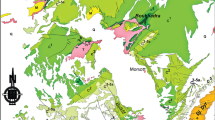Summary
The Speewah fluorite deposit (>2.28 Mt at 25.5% CaF2) is sited adjacent to the crustal-scale Greenvale Fault on the western side of the Halls Creek Orogen, in the East Kimberley region of Western Australia. Host rocks are Palaeoproterozoic sedimentary rocks, dolerite and granophyre, Early Cambrian basalt, and the Yungul carbonatite. The deposit comprises mainly fluorite–quartz veins associated with lesser barite, sulfides and calcite, controlled by NNE–SSW and N–S brittle faults and fractures. Cross-cutting field relationships indicate that the fluorite veins were deposited post Early Cambrian.
Fluorite–quartz vein textures, including colloform banding and comb texture, combined with microthermometric data from primary fluid inclusions, indicate that fluorite was deposited by the incremental infill of open-space structures in an epizonal, and probably epithermal, environment (<160 °C) from complex, Li–Ca–Mg-rich, highly saline ore-fluids.
The Yungul carbonatite and intimately-associated replacement-type fluorite have similar levels of REE enrichment and identical chondrite-normalised HREE patterns. Samarium and neodymium isotopic analyses of the fluorite indicate extreme differentiation of the 147Sm/144Nd ratio, from 0.0709 to 0.6918. These Sm–Nd isotopic data correspond to a mineral isochron with an age of 122±24 Ma, interpreted to represent the age of fluorite deposition.
Based on the potentially magmatic fluid composition, the replacement-type fluorite within the carbonatite, the similar HREE patterns of fluorite and carbonatite, and direct, if imprecise, isotopic dating of the fluorite, which confirms that fluorite mineralization is younger than the Early Cambrian basalts, the Speewah fluorite deposit is interpreted to be genetically related to the Yungul carbonatite. The large fluorite resource cannot have been derived from the exposed, low-volume carbonatite dyke. Rather, it must have been sourced from a larger carbonatite body at depth, whose presence is implied from basement-derived xenocrystic zircons in the Yungul carbonatite.
Similar content being viewed by others
Author information
Authors and Affiliations
Rights and permissions
About this article
Cite this article
Alvin, M., Dunphy, J. & Groves, D. Nature and genesis of a carbonatite-associated fluorite deposit at Speewah, East Kimberley region, Western Australia. Mineralogy and Petrology 80, 127–153 (2004). https://doi.org/10.1007/s00710-003-0015-3
Accepted:
Issue Date:
DOI: https://doi.org/10.1007/s00710-003-0015-3




